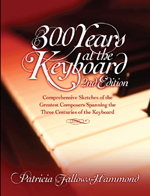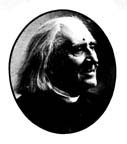Composer Example: Liszt
We have produced a 312 page book that covers 17 of the greatest classical keyboard composers in history. For each composer we give a historical sketch of the composer, commentary on their style, commentary on their more important works and sample sheet music they have produced. We follow this with a comprehensive list of all their works so if you like what a composer is like you can instantly go order some or all of their sheet music.
In this discussion, we will give you a sample of the presentation we do for each composer.
Franz Liszt
Born in Raiding, Hungary
October 22, 1811
Died in Bayreuth, Germany
July 31, 1886,
Age 75 years
Historical Sketch
Franz Liszt was born into a milieu of musical performance through
his father’s position as steward on the Esterházy estate and as cellist in
the court orchestra there. The Esterházy family had played an important part
in music history, notably in the case of Haydn, before Liszt was born.
Through the years, the family supported music, subsidized orchestras, and
engaged composers and performers who were among the finest of the day. When
Liszt was ten years old, the Esterházys and local Hungarian families
financed his piano study in Vienna. As with Haydn, Mozart, Beethoven, and
Schubert, Vienna in Liszt’s youth was one of Europe’s important music
centers. At eleven, Liszt gave his first public concert, and at twelve, his
first concert tour of Europe, including the German cities of Munich and
Stuttgart. After the tour, he settled in Paris where his playing was a
sensational success. He performed some of his own compositions in Paris, and
soon London, and set the stage for his beginnings as a serious composer. His
definitive work in 1826 was the original version of the
Transcendental Etudes.
At 19, Liszt met Berlioz, the first of the three musicians who were
to exert an indelible influence on his style. Berlioz, composer of the
Fantastic Symphony,1
stirred in Liszt a diabolical streak through daring and bizarre harmonic
innovations. The other two were Paganini, a phenomenal violin virtuoso
spoken of as the devil himself, who inspired Liszt’s awesome ranges of
pianistic bravura, and Chopin, who countered diabolism and excessive
virtuosity with grace and poetry. Liszt absorbed these influences into his
own natural expression to create works that extended through the years from
heroic fire to religious meditation to startling bleakness. By 1830, Liszt
was on the threshold of his career and within four years established himself
as a serious and original composer with works which included
La Campanella, Harmonies
poétiqnes et religieuses,2
De Profundis for Piano and Orchestra,3 and the set of
3 Apparitions.
In his early twenties, Liszt eloped to Switzerland and Italy with
Countess d’Agoult (better known by her literary name of Daniel Stern), a
friend of Chopin and George Sand. The liaison inspired sketches of the
1st Book of Années de pèlerinage
(Switzerland), completion of the
2nd book
(Italy), as well as first versions of the
Paganini Etudes, 12 Transcendental Etudes, and
Todentanz for Piano and
Orchestra. In 1838, a daughter, Cosima, was born who
was later to become the wife of Richard Wagner.4 Six years after Cosima’s
birth, Liszt and the Countess separated.
At the height of his career as a concert pianist, Liszt retired to
Weimar in 1846 to conduct occasional concerts of the court orchestra. Two
years later, he was appointed as full-time conductor, a post he held for the
next twelve years. He began a new liaison with Princess Carolyne Sayn-Wittgenstein,
who was a strong influence on his creative drive. During these years of
1848-60, with the Princess’s encouragement,…..
Style
Liszt’s strength of vision lasted a lifetime, giving his style
power and originality. Like Mendelssohn and Schumann, he was influenced by
arts other than music — literature and painting. He came close to realizing
his dream that music should embody the world through his all inclusive
contributions as conductor, composer, arranger, and pianist. His restless
intellect explored the possibilities of freeing form from its association
with Classical structures. This led to his successful use of thematic
transformation where he invented his own forms and developed a harmony of
extreme chromaticism to support them, a harmony which he pushed beyond the
limits of recognized key relationships. He outstripped the evolving ideas of
Romanticism by ingenious combinations unique to his own style-the lyricism
of Italian cantilena, Mendelssohnian lightness and playfulness, the violence
of unrestrained orchestral sound, and nationalist rhythmic drive.
As pianist, Liszt was generally accepted as the greatest of his
time. Called the “virtuoso of virtuosi,” he developed piano technique to the
limits of physical possibility. His “transcendental technique” explored
every resource of the piano and pushed on to orchestral effects which he
sometimes……..
Compositions
Liszt’s works fall into three classes:
transcriptions and arrangements; program music; absolute music.
The bulk lies in the first group, transcriptons and arrangements,
based on operatic, vocal (single songs) and instrumental works by himself
and other composers, including Mozart, Beethoven, Schubert, Schumann,
Chopin, Mendelssohn, and Wagner. While some of the
transcriptions
intensify the original musical idea, there is rarely enough
enhancement or originality to make them more than historically interesting.
Exceptions are the
Transcendental Etudes
after Paganini,
the famous
Liebestraum, the Schubert
Soirées de Vienne,
and the
Mephisto Waltzes.
Transcendental Etudes after Paganini R.3a
(1838)
Dedicated to Clara Schumann These are six studies which include
Tremolo study in G minor, Octave study in D flat,
the famous
La campanella, Arpeggio
study in E, La Chasse,
and
Theme and Variations in A minor.
The first version……..
Lots more…….More about the publication, including reviews by major magazines and sample pages from the book can be found by clicking here:
![]()




